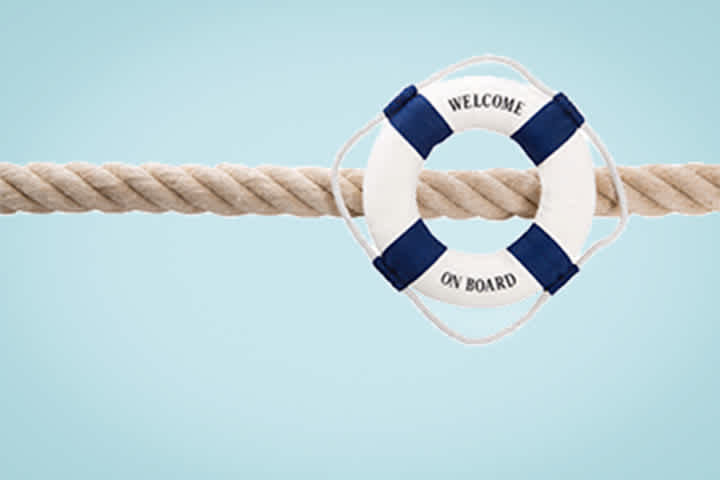Will there be a recession in the US?
Keytrade Bank
keytradebank.be
April 09, 2025
3 minutes to read
In the first Harry Potter book, no one dares speak of He Who Must Not Be Named. That's how afraid the young wizards are of him becoming a reality. In the financial world, there is a similar word: recession.
In recent weeks, economists, investors and financial journalists have started to whisper the R-word more often. In March, the word was used three times as often in the media as in January. Google searches for the word are also increasing markedly.
This raises louder questions on a pending recession: is there really one on our doorstep? Or are we simply scaring ourselves? And if one is coming, how bad will it be for investors?
Recession: made in the USA?
The world's largest economy, the US, is on the proverbial edge of its seat. In the wake of a strong recovery after the pandemic, a recession seemed unlikely until recently. Unemployment was low, Joe Sixpack was avidly consuming products and services, businesses were investing, and Wall Street was hitting record highs. Since the change in the White House in early 2025, however, a different wind has been blowing across the world, resulting in drastic economic measures that have greatly increased the risk of a recession, i.e. an economic contraction.
The low point so far was 2 April, when Trump unleashed a massive tariffs blitz. He imposed a baseline 10% tariff on all imports, plus additional tariffs for countries which have major trade deficits with the US. The tariffs even target an uninhabited island. Basic products that the US barely produces itself, such as coffee, tea and bananas, are also subjected to the tariffs. The same tariff treatment is applied to countries whose imports from the US exceed their exports to the US – such as The Netherlands.
Experimenting with the economy
Olu Sonola, head of US Economic Research at Fitch Ratings, said in a statement to the Financial Times that the average import rate is now 22% compared to 2.5% last year. This is the highest level since 1910 and marks a historic break from the free trade era and a turning point for both the US and the global economy. Or as The Economist put it: the country that was the architect of global trade and has benefited greatly from it in the past 80 years, is now trying to demolish it. Trump inherited a growing economy in January. Wall Street speculated that it would go for full deregulation and cut taxes to stimulate growth. You only need to take one look at the stock market to see that those expectations have taken a sharp turn in recent weeks.
Surged inflation, stifled growth
In practice, high import tariffs have the same effect as a tax increase on consumers and businesses. Imported goods become more expensive, which drives up inflation. Fund manager Schroders estimated that the new rates could drive up US inflation by around 2 percentage points. At the same time, more expensive imports and possible retaliatory tariffs from other countries will hinder the US economy and result in an estimated growth loss of almost 1 percentage point of GDP. This combination of rising prices and sluggish growth is a scary prospect for the world's largest economy, with the curse of stagflation (stagnation + inflation) looming.
US companies are facing higher costs for their parts and raw materials. They cannot pass on all these extra costs to customers, so many US companies will see their profit margins shrink. During Trump’s previous trade war in 2018, manufacturers were able to pass on around 60% of the additional import costs to consumers. The rest squeezed their profits. Now that the introduced package is even more comprehensive, consumers will experience price increases almost everywhere, which will drain their purchasing power.
Code orange
In March – even before Liberation Day – consumer confidence had already fallen to its lowest level in more than four years. Households explicitly cited the new trade barriers and price increases as reasons for their concern. Shortly after the November elections, Americans were still optimistic, but that optimism has now completely dissipated. Economists warn that such a dip in confidence is not without consequences: if enough people tighten their purse strings for fear of a recession, that recession may actually become a reality – a self-fulfilling prophecy.
And that’s not the only warning sign. Businesses are also becoming more cautious. Consequently, capital investments, which are drivers of growth, are starting to falter. Shortly before Liberation Day, US business investment forecasts had already been downgraded from the 2.5% annual growth expected at the beginning of January to 1.9%.
The Federal Reserve: between a rock and a hard place
When the economy slows down, the US Federal Reserve normally intervenes. It can cut interest rates to make loans cheaper, encourage investment and give the economy a boost. However, the current situation presents the Fed with a devilish dilemma, as the new import tariffs may cause inflation to rise again. Under normal circumstances, the Federal Reserve would need to raise interest rates to control such a surge in inflation. However, economic growth is threatening to deteriorate, and that would require a cut in interest rates to avoid a recession. In other words: Trump's trade policy may cause a stagflationary shock.
Is recession inevitable or may the tide still turn?
Does this make a US recession inevitable? More and more economists consider it more likely that the US economy will effectively contract by the end of 2025. Some banks, such as HSBC, see a 40% probability of a recession in the next 12 months. Others are more pessimistic. JP Morgan believes there is now a 60% chance of a (global) recession. Still, there is no absolute certainty yet. There are conceivable scenarios in which the tide could still turn, or the damage could be limited. Trump himself often sends different signals. On the one hand, he now accepts the idea that Americans may “feel some pain” to achieve his dream of America's new golden age. On the other hand, the President has already hinted that exceptions are possible. It is therefore certainly possible that he will still put on the brakes (when Wall Street really starts to struggle). And if the economic data deteriorates dramatically in the months ahead, the Fed could be even more aggressive in its easing than expected, although this will always be a tricky balancing act due to inflationary pressures.
Also bear in mind that recessions are difficult to predict. In 2007, right before the largest economic downturn since World War II, only 38% of economists predicted a US recession. And in 2022, 63% of economists predicted a US recession that never materialised. However, back then, there was no trade conflict of this magnitude. Today, some hard data (such as falling investments) as well as soft data (confidence, stock market sentiment) are gradually pointing towards cooler economic times in the US. So much depends on one man in the White House – and that makes forecasts uncertain.
Wildfire or controlled burn?
When the world’s largest economy sputters, other countries immediately feel the consequences. Europe is experiencing the first side-effects of the US storm. The EU got an unpleasant surprise when Trump announced a 20% tariff on its exports to the US as part of his tariffs package. This bad news arrived at a time when the European economy is growing relatively moderately. European companies – from German car manufacturers to Belgian brewers – are suddenly seeing their access to a crucial US market become far more expensive, which is weakening their competitive position. And if the US economy shrinks, European exporters will also get fewer orders.
In this scenario, the European Central Bank faces a similar challenge as the Fed. On the one hand, inflation is still on the high side in Europe, and on the other hand, these trade tensions are threatening to cause a new economic headwind. Further interest rate cuts may be necessary to prevent an even bigger slowdown in growth. In addition, calls for fiscal stimuli are sounding louder. In Germany – traditionally a frugal country – large investment programmes are already in the pipeline. This type of public spending could act as a buffer.
Meanwhile, in China
China, the second-largest economy, is also caught in the storm with a major 34% tariff added to the existing 20% tariff. This threatens to stifle China's export machine, even though the country has responded with countermeasures immediately. Chinese growth has been cooling for several years, so this trade war has come at a very bad time. Beijing had been preparing itself with stimulus measures on the home front, such as additional government investment, tax cuts and support for consumption. The idea is to make the economy rely more on domestic demand now that exports are becoming more difficult. In fact, China has been trying this trick for years – with mixed results – but there is far more urgency now. China will struggle to achieve its 5% growth target for 2025 if the US enters a recession.
Emerging markets in the firing line
Emerging markets are particularly vulnerable to global shock waves. Many developing countries rely heavily on global trade and investment flows from the West. If the US slides into recession and demand for commodities and goods declines, they will feel the impact immediately. In addition, the increased uncertainty is causing international investors to shun risk. A classic pattern then emerges in which investors leave riskier markets and flee to safe havens, putting their capital in US and European government bonds, gold, the Japanese yen, ...
What does this mean for investors?
These are turbulent times for investors. All stock markets fell sharply instantly. Wall Street experienced its worst day in years when the new tariffs were announced. In such an investment climate, it is important to cast a critical eye over your investments and possibly reposition them for more security where necessary. Here are some concrete ways investors can deal with recession fears:
- Review your exposure to shares: Historically, shares suffer the most from recessions, as corporate earnings fall. That doesn't mean you have to sell everything. Timing the market is very difficult and dips are often soon followed by a recovery. In the long term, the global economy also grows more than it ever shrinks. For some investors, however, it may make sense to reduce some of the risk. Defensive industries may be an option: even in a recession, demand is generally more stable for companies providing essential goods and services, such as supermarkets and food producers, the pharmaceutical/healthcare industry and utility companies. Such shares are no guarantee against price declines, but they do tend to hold up better than the market overall. Quality companies with strong balance sheets and fixed cash flows (some telecom and infrastructure companies, for instance) can also be more attractive to investors who want to play it safe.
- Bonds: Bonds can act as a shock absorber in a portfolio. Why? When a recession approaches, the central banks are likely to cut interest rates, which will push up the prices of existing bonds. However, when inflation rises sharply due to import tariffs, the central banks will have to respond by significantly raising interest rates, which could be detrimental to bondholders. Although bonds may help as a buffer, they are not a failsafe solution and need to be selected carefully.
- Gold: Gold is often called the ultimate insurance policy for a crisis. The precious metal has historically done well in times of weak growth and political uncertainty. The price of gold has already risen sharply, but may increase further as investors worldwide look for an inflation-proof safe haven. Please note that gold doesn't generate income through interest or dividends. Its returns come solely from price appreciation.
- Cash (to a certain extent): In uncertain times, it may be helpful to hold some more cash. Cash offers flexibility and prevents you from being forced to sell investments at an unfavourable time. In a scenario where the market continues to fall, some cash in your portfolio will allow you to pick up some quality shares later. Bear in mind, of course, that cash is slowly corroded by inflation. It is therefore not a long-term investment.
- Diversification and long term: Don't forget the old adage of not putting all your eggs in one basket. Spread your investments across different regions, industries and instruments. Rebalancing may be appropriate for some investors.
- Stay calm. It is understandable that headlines about a possible recession are making you nervous, but panic is rarely a good investment strategy. Make sure your portfolio matches your financial capacity and horizon. The best and worst stock market days are often not that far apart, and if you miss those good days, you will fall much further behind.


